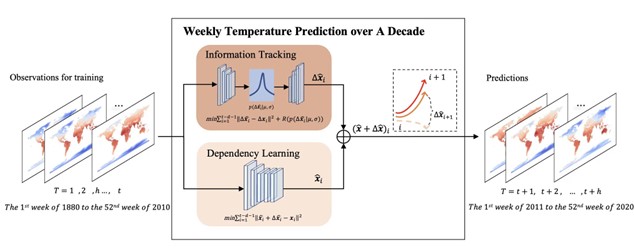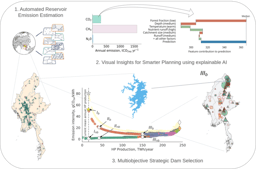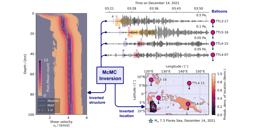A Breakthrough in Decadal Temperature Predictions with Chaotic Information Tracking
Published in Earth & Environment and Mathematical & Computational Engineering Applications

Our latest research, published in the Nature Portfolio Journal, Communications Earth & Environment, is titled “Consecutive one-week model predictions of land surface temperature stay on track for a decade with chaotic behavior tracking.” This study represents a significant advancement in the field of climate science and temperature prediction.
Understanding the Challenge
Predicting temperature changes over a decade is a complex task due to the chaotic nature of climate systems. Small variations in initial conditions can lead to vastly different outcomes, making long-term predictions challenging for existing climate modeling and machine learning methods which often struggle with accumulating errors over extended periods.
Methodological Originality
Our study introduces a novel machine learning paradigm that continuously learns and adapts to changes in temperature, ensuring more accurate predictions. This paradigm is not a simple application of AI but represents a methodological breakthrough in climate prediction.
Key Components
- Dependency Learning Component (DLC): This component studies past weather patterns to understand how temperatures change over time. DLC uses historical temperature data to identify patterns and dependencies that influence future temperatures.
- Information Tracking Component (ITC): The heart of our method, ITC, monitors and corrects potential prediction errors, similar to a spell-checker for weather forecasts. ITC employs a feedback mechanism to adjust predictions based on observed discrepancies, maintaining accuracy over longer periods.
Why Our Methods Work
Unlike existing climate modeling and machine learning models that may become less effective over time, our model continuously updates its predictions based on the ITC, as shown in the following figure, ensuring that any deviations between predicted and actual temperatures are promptly corrected, preventing long-term drift in predictions.

Figure 1. The proposed method comprises two components: a dependency learning component (DLC) and an information tracking component (ITC). In each step of the prediction, the DLC looks at how temperatures have changed over time and space to make predictions about future temperatures; while the ITC aims to prevent the accumulation of prediction errors generated from the DLC by providing a feedback of the estimated prediction error, quantified by the first-order difference of the target variable. With the compensation in each step, as shown in the box with dashed borders, the proposed method is designed to alleviate the exponential increase of error.
Why It Matters: Real-World Impact
Accurate long-term temperature predictions are crucial for various sectors, providing both immediate and long-term benefits. Here's why this research is significant and how it impacts the real world:
- Agriculture: Farmers rely heavily on weather forecasts to make critical decisions about planting, irrigation, and harvesting. With more accurate long-term temperature predictions, farmers can optimize their schedules, reducing the risk of crop loss due to unanticipated weather changes. This can lead to more stable food supplies and potentially lower food prices. For example, in regions prone to droughts, accurate temperature forecasts can help farmers decide when to plant drought-resistant crops or when to invest in irrigation systems.
- Public Health: Extreme weather events, such as heatwaves and cold spells, pose significant health risks, particularly to vulnerable populations like the elderly and those with preexisting conditions. Improved temperature predictions allow health authorities to prepare more effectively, ensuring that adequate resources, such as cooling centers and medical supplies, are available when needed. For instance, accurate predictions of heatwaves can lead to timely public health advisories, mobilization of emergency services, and distribution of cooling resources to prevent heat-related illnesses and deaths.
- Biodiversity and Conservation: Climate change is one of the greatest threats to biodiversity. Species that cannot adapt quickly enough to changing temperatures are at risk of extinction. Accurate temperature predictions can help conservationists develop more effective strategies to protect endangered species, such as creating migration corridors or adjusting the timing of conservation actions to better align with climate patterns. Conservationists can use long-term temperature predictions to anticipate and mitigate the impacts of climate change on wildlife. For example, they can plan ahead for the relocation of species to more suitable habitats or implement measures to protect critical ecosystems from temperature extremes.
By maintaining a constant error level and preventing exponential error accumulation, the method provides more reliable long-term predictions, leading to better preparedness and response to climate-related challenges.
Looking Ahead
As we move forward, there are several opportunities to expand and refine this research. Here are some key areas of focus:
- Enhanced Data Integration: Incorporating additional data sources, such as satellite imagery and real-time sensor data, can further improve the accuracy and reliability of temperature predictions. This integration can provide a more comprehensive understanding of climate patterns and their impacts.
- Broader Applications: While the current focus is on temperature predictions, the underlying methodology can be adapted for other climate variables, such as precipitation and wind patterns. This versatility can enhance our ability to predict and respond to various weather-related events.
- Collaboration and Partnerships: Engaging with other researchers, institutions, and industry partners can foster innovation and accelerate the development of more robust climate prediction tools. Collaborative efforts can also facilitate the sharing of data and resources, leading to more comprehensive and effective solutions.
- Policy and Decision-Making Support: By providing more accurate and reliable climate predictions, this research can inform policy decisions and strategic planning. Governments, businesses, and communities can use these insights to develop more effective climate adaptation and mitigation strategies.
By focusing on these areas, we can continue to enhance the predictive capabilities of our method and contribute to a better understanding and management of climate-related challenges.
For those interested in the technical details and experimental results, you can read the full paper: https://www.nature.com/articles/s43247-024-01801-0 or https://rdcu.be/dX8Bx. Feel free to reach out if you have any questions or would like to learn more about our research!
Follow the Topic
-
Communications Earth & Environment

An open access journal from Nature Portfolio that publishes high-quality research, reviews and commentary in the Earth, environmental and planetary sciences.
Related Collections
With Collections, you can get published faster and increase your visibility.
Geology of the Moon
Publishing Model: Hybrid
Deadline: Jan 31, 2026
Drought
Publishing Model: Hybrid
Deadline: Dec 31, 2025




Please sign in or register for FREE
If you are a registered user on Research Communities by Springer Nature, please sign in